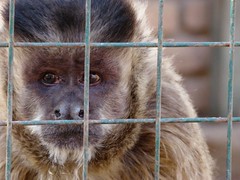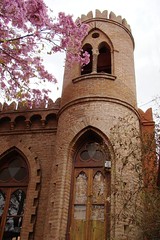La Rioja is a relatively small provincial capital, and I don't have much to say about it, although I do want to be fair and emphasize that we visited it in a hurry and because we had to, since the return bus to Rosario departed from there rather than from Chilecito. La Rioja is cute, but it has no major remarkable touristic spots, with the exception of a huge palaentology museum and some historical churches. The cathedral is also beautiful, but at this stage of our vacations we were no longer terribly impressed about this sort of things.
There's a house resembling a castle where the famous Joaquín V. González lived (the one who built Samay Huasi in Chilecito as a house of rest), and a fair amount of ample, well cared-for public squares, but no big parks within the urban downtown area.
 Parque Yacampis, the public park where the zoo is located, lies almost outside of town, and either because of the drought or sheer carelessness it looks rather decrepit. The zoo itself is surprisingly large and comprehensive for such a small city, and we spent a couple of hours going from one cage and enclosure to another. Among the primates there are caí monkeys (capuchins), a spider monkey, and baboons; also many birds, including a miserable condor which seemed to have too little space to exercise its vast wingspan; llamas and guanacos, too, and less curious animals such as goats and pigs.
Parque Yacampis, the public park where the zoo is located, lies almost outside of town, and either because of the drought or sheer carelessness it looks rather decrepit. The zoo itself is surprisingly large and comprehensive for such a small city, and we spent a couple of hours going from one cage and enclosure to another. Among the primates there are caí monkeys (capuchins), a spider monkey, and baboons; also many birds, including a miserable condor which seemed to have too little space to exercise its vast wingspan; llamas and guanacos, too, and less curious animals such as goats and pigs.The "problem" (note the scare quotes) with La Rioja is that, touristic or not, it's a "deep country" city with a small town mentality, and siesta time is sacred, so even the finest restaurant on the best parts of downtown shoo off customers during the afternoon. The traveller that arrives from Chilecito, for instance, checks in at the hotel and goes looking for late lunch, is in for a bad surprise and will be forced to a hungry pilgrimage around the city before he or she can find a table and a waiter.
We stayed in La Rioja all Friday afternoon and Saturday until sunset, when our bus departed. Again we had the unforgettable experience of an interrupted return trip. In March, you'll remember, we were stopped en route by a picket of farmers near Villa María, Córdoba; now it was a bit earlier, when the engine failed and started losing diesel. Marisa, doubtless because of the fuel vapours, felt sick all night; she couldn't force herself to eat so much as a mouthful of dinner, and the nausea lasted even a couple of days after our return. Fortunately we weren't delayed a lot: we stopped in La Falda, north of Córdoba, and we waited an hour or so until a replacement bus was sent from nearby Capilla del Monte. So in the end we got to Rosario two hours after schedule.
And that's the end of my vacation report.














Hey - Welcome home. I have skipped my morning reads as of late, as I have started being productive and gone shooting (photos not guns) in the mornings for the last while.
ReplyDeleteIt is so funny what you say about the siesta. It is similar everywhere in the North West. In San Juan it is no different. I actually had a restaurant close and leave us on their patio with out meals. They never asked for money, they never asked us to leave, they just went home.
Hey Jeff! I'm glad I got the idea across. I'm all for preserving local traditions, and La Rioja City actually isn't selling itself as a tourist-friendly town, but when lunch time comes and there's no place to sit down and eat, it's just cruel to have all those restaurants with their doors closed. I was thinking of the money they fail to make during all those those hours, but I guess if I presented the issue to the Riojanos that way, they'd very sensibly reply that no-one goes out to eat at siesta time (except a few disoriented tourists).
ReplyDeleteIts pretty interesting in La Rioja and Catamarca. I have read recent reports about their protests and stance against seveeral large mining projects.
ReplyDeleteThe fact that they are willing to sacrifice high paying jobs to preserve their water sources, their fields and their community is impressive. While I am sure there were several people who wanted the job, the money and didn't care about the consequence, but its amazing when the majority wants to maintain the status quo and live a slower paced life.